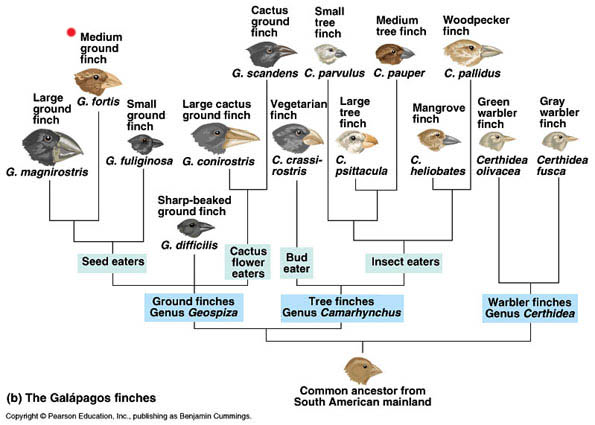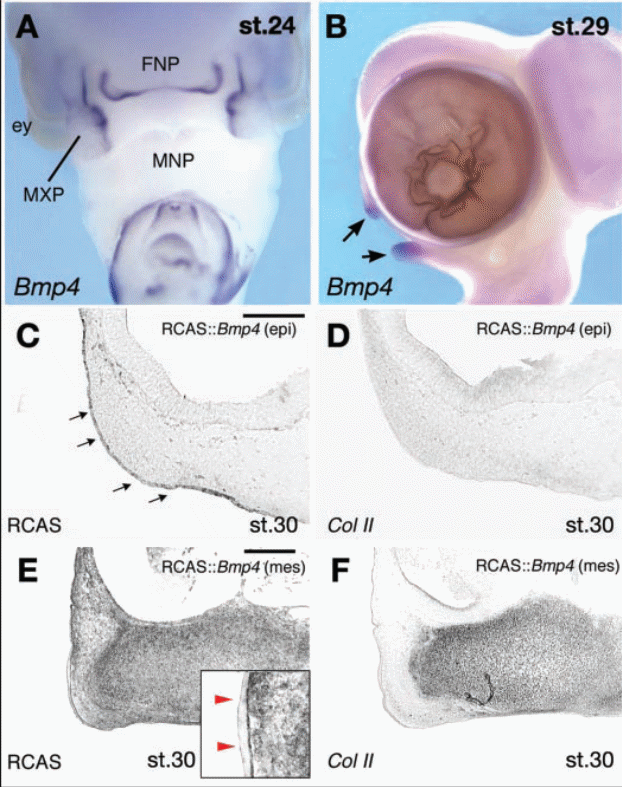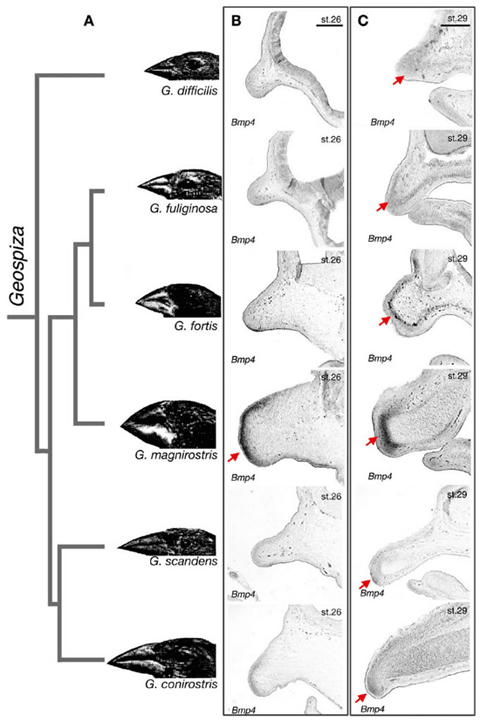Bone morphogenic protein 4 or known as the Bmp4 is studied because of its great component and role in beak formation of the Galapagos Finches and other bird species. The scientists studied the expression of the Bmp4 gene due to the molecular basis in the size and shape of the beaks. (Alberch,P., 1982)
In 1859, Charles Darwin wrote about “The Origin of Species”. It presented the wealth of evidence of evolution and stated that all living things in this world today have their ancestors with modifications. He also stated in the book about the mechanism of the natural selection in which he explained the evolution process (Darwin, C., pp. 304-305).
In his evolution theory, he indicated two interrelated phenomena. First is the adaptation in which the species modifies their phenotypes in a way they adapt to their respective environment. Second phenomena is the speciation by which the number of species multiples and with the multiplication process, these species give rise to two or more descendant species. Therefore, Darwin stated that with all certain type of species on earth today they shared a common ancestor. (Gould, SJ.,1982)
Natural selection of various species has been one of the central systematic and organizing principles of biology. It becomes possible in studying the natural selection of the species in most fundamental level. It was assumed that the natural populations are extremely large.
The Darwin’s finches or also known as the Galapagos Finches have 13 or 14 different species found in Galapagos Island during his Beagle voyage, thirteen of which found in Galapagos Island and the other one in Island of Cocos (Darwin, C., pp.207-209).

These birds are all about the same size but differ in their beak’s sizes and shapes and also they differ in their behavioral aspects and to their melodies. The Galapagos Finches is assumed to an inspiration in Darwin’s Theory of Evolutions. (Sulloway 1982) The illustration of the ability of the nature to generate morphological diversity comes from the Darwin’s finches. Through this, Galapagos Finches became the examples of research in evolutionary biology.
These bird species most likely had descended from their common ancestor in which developed differences of their beaks. These differences matched with their confinement in several islands and their adaptation in several ecological places. Scientists also had pinpointed that a molecular basis for variations in sizes in Galapagos finches that observed by Charles Darwin more than a century and half ago. (Darwin, C., pp.207-209)
The beak shape of the finches and other bird species is considered to a classical example of evolutionary diversification. It shares at least three distinct features in their developmental programs and predisposes them potentially to the evolutionary transformations. These developmental programs seem to employ epithelial and mesenchymal cells which produce composite structures. Mesenchymal cell serves as a conductive target for natural selection and a driving force in generating variation which is the phenotypic. The beaks also operate as modules in integrated molecular and historical situations in the past. These may have involved in the series of epithelial-mesenchymal interactions that are mediated by several signal pathways and are then regulated by the cellular equivalent mechanisms. The beaks also possess apparent capacity to fluctuate in time. This feature measures the extent of which ontogenetic syste,s can respond to external and internal pertubations and it can produce an integrated obtainable phenotype. (Sharpe PM and Ferguson MW.,1988)
The differences in the beak shapes are caused by the molecular and cellular level. Epitthelial and mesenchymal cells distinctly differs embryonic origins and unique abilties to pattern during the morphogenesis. Although beaks vary extremely in the species of birds, the embryonic stages that all rise from the comparative cells, tissues, and primordial. Beaks are primarily a cache of “facial prominences” and these grow in an unevenly rates during the development of the chick in order to compose a beak that is unique. In other words, this is the key understanding in evolution and variation that explains the genetic activities that also results in the abnormal and healthy human facial development. (Sharpe PM and Ferguson MW.,1988)
The diagram shows the fourteen species of finches with their genus and common found in Galapagos Island and Cocos Island. (Dr. Rothman, R., 2000).
The diversity of the beak’s structure and habits in eating is remarkable. The bird’s ability to find food is what they called the beak. Aside from ability to find food, bird’s beaks also can build their nests and perform many other functions. Biologists intrigues on the way that the different species of finches have evolved. Chickens and ducks are compared during the observation of the beak development. Chicken beaks have a conical shape and are small while the beak of the ducks found to be long and wide. It found out that the chickens and ducks are two areas of developing frontonasal mesenchyme in which the division of the cells occurred rapidly in order to create the mass of the beaks. These two areas converged in to one on the distal end of the beak of the chicken which is sharp and has a growing tip. Meanwhile, proliferative zones remained in duck’s beaks which created a bigger and wider beak (Futuyma, D. J.,1998).
The importance of the Bmp4 expression was first published by Peter and Rosemary Grant. As the changes in habitat and availability of the seed on the environment favored some of the finches and some generations of birds showed the different beak shapes.
With the used of the situ hybridization, the researches tracked the number level of the growth-related genes. They found out that the expression of the Bmp4 is a mediator growth (Schluter , D.,2000).
In humans, it plays a role of increasing the rates of the division of the cell and its growth in regulating major developmental situations including the differentiation of the bone. Bmp4 deregulation pathway activity been linked to some of the growth of the tumor. It also demonstrated that the controlling of the Bmp4 gene expression. The determination of unique domains in Bmp4 controlled gene suggests that differentiation if transcriptional factors make the Bmp4 level at different stages during morphogenesis (Schluter , D., 2000).
To test that Bmp4 is a growth meditor, these scientists used the techniques from the gene therapy and protein delivery to mis-express and together with its antagonists. Eggs of the wild finches were gathered and compared the development of the beak in embryos in six different finches’ species. The expression of the Bmp4 gene resulted that it varies on their beak’s shape and size. The scientists found out and identified that the Bmp4 is a major mediator of the shape of the beak in many finches’ species. Bmp4 as to be the major component in creation of the avain beak demonstrate that it is also one of the major forces in building beak mass. They also stated that of this Bmp4 expression towards the beaks then it could be a key player in the molecular basis of the diversity of the species (Schluter , D.,2000).
The connection between the studies of the animal and the whole variety of craniofacial syndrome has really good impact. He also noted that the developmental processes are most likely the same with the humans. In the recent research shows the role of the Bmp4 expression in the evolution in the beak morphology in Darwin’s finches (Galapagos Island).(Futuyma, D. J.,1998)
The evolutionary changes arise from the heterochronic shifts and heterotopic shifts. The ontogentic events timing refers to heterochronic while the ontogenetiv events’ spatial expression refers to heterotopic. The five dimensions of ontogeny and phylogeny capture by Edelman’s heterotopy and Gould’s heterochrony (Futuyma, D. J.,1998).

With this dimensions, the evolutionary and developmental synthesis is so hard to achieve. “The heterochronic manipulations of the Bmp4 expression during the development of the chick and reproduce the patterns comparatively that has been obser4ved in the Galapagos or Darwin’s finches”. The expression of the Bmp4 gene in retroviral vector is clearly seen by allowing them to infect the specific layer of cell groups. Ectodermal cells versus mesenchymal cells can influence the retroviral vector due to disallowing the crossing of the basement membrane to separate the two cell layers. Chicken embryo’s mesenchyme cells infected with the retroviral vector. Such heterochronic shifts develops in to a large-beaked morphology characteristic named Geopiza magnirostis. This is most likely the Bmp4 expression in mesenchymal cell than any other species of the ground finch genus (Hall BK, 1984).

The heterotopic shifts greatly effect the expression of the Bmp4 in several cell layers. In the same retroviral vector, it infects (Bmp4) the ectodermal cells in the beak development. This obtained the beak morphology of the chick embryos, whether it would be smaller or narrower in shape which is the opposite of the mesenchymal cell layers infection. Heterochronic and heterotropic expression of the Bmp4 gives way to obtain both svelte-beaked form of the ancestor of the ground finch, robust-beaked form of G. magnirostris, and with the G. difficilis’ beak (Hall BK, 1984).
“The changes in morphology of the beak among the Galapagos finches (Darwin’s finches) were not affiliated with the two Bmp4 regulators which is the sonic hedgehog and the fibroblast growth factor”. These two regulators have a great influence in the development of the cranium in its proper location of the cells in which it eventually enhances into the beak formation and induces the Bmp4 expression. (Abzahnov and Tabin, 2004) However, the Shh and the Fgf8 does not make any influence between the large- and small-beaked species of Darwin’s finches. The injection of the retroviral vector on the mesechymal cell did not construct with the Noggin gene which it antagonizes the signal of the Bmp4 and reduced the sizes of the upper beak of the chicks. “The potential epistatic connections of other regulatory genes does not even ruled out but it does narrow the research process that affects the Bmp4 gene expression” (Chuong CM, et al, 2000).
The research and findings about the evolutionary and developmental origin of adaptive radiation indicates that example of the Darwin’s theory of evolution. It even gives us the understanding on morphological diversities in a minimum amount of changes in the information. The heterochronic shifts together with the heterotopic changes brought up the regulation of a single gene and gives abysmal group of topological shifts to develop an unlimited set of morphological diversities (Alberch,P, 1982).

The Darwin’s finches’ are known example is an achievement of an evodevo synthesis and until now the natural selection of the Darwin’s finches in Galapagos Island still and becoming more intense. The elucidation of the Bmp4 expression in Darwin’s finches exhibit large-, small-, and mega-beaked forms. (Smith, 1993,1997). Contributions of species’ polymorphism in morphological radiation are still unclear. Such research is very useful especially in the causes of the development and natural selection. Moreover, the explanation on the heterotrophy and heterochrony’s involvement in polymorph intraspecies will be the next step in the research since it gives us the study of its action of the natural selection in the sizes and shapes of the beak and even a regulators and modifiers of the Bmp4 expression is still on the process (Smith, 1993).
Implantation of bone morphogenetic protein 4 (Bmp4) used as a carrier or by transfer of Bmp gene induces formation of the bone and the beaks of the finches. The researchers analyzed that the gene expression of chondrogenic and osteogenic specific markers in the process of bone formation by using the semi-quantitative RT-PCR. (Alberch,P, 1982)
The idea that the ontogeny plays a big role in shaping the evolutionary process or the phylogeny that has been a long research and study. Most research has emphasized that the development process can generate the phenotype diversity. Galapagos Finches’ have recently succeeded the extraordinary variation to understand more about the ontogenesis and phylogeny process. The current identification of the Bmp4 expression concluded that the evolution of the cells could be considered in terms of innovations that will be a great contribution in the craniofacial development of the all the species. Its clear that the changes in the patterns of the Bmp4 expression of the transcriptional regulating genes formed together with the plasticity of the cells which which found out to have changes in the morphology of the craniofacial structures and it even contributed on the adaption of the species to a new rapidly environmental changes. The results of the gene regulation seem to have a result of many mechanism by which it regulates the evolution and the challenge in order to see the cellular and genetic interactions occurring in the involved cells and its adaption to evolving populations and the specific regulating factors that affects the entirety of the evolutionary process (Alberch,P, 1982).
References
Alberch,P. The generative and regulatory roles of development in evolution. In: Mossakowski D, Roth G.,editors. Environmental Adaptation and Evolution: a Theoretical and Empirical Approach. Stuttgart:G. Fischer-Verlag; 1982. pp. 19–36.
Bennett, A.F., Lenski, R.E., & Mittler, J.E. (1992). ìEvolutionary Adaptation to Temperature I.46:16-30.
Burt L. Monroe and Charles G. Sibley, A World Checklist of Birds. New Haven, Conn.: Yale University Press (1993).
Darwin, C. The Origin of Species. Chapter 4.The natural selection, pp 305. New York: The Crowell-Collier Publishing Co; 1859.
Darwin,C. The Voyage of the Beagle. pp. 207-209 (New AmericanLibrary, New York, 1988).
Darwin, Francis (1887), “Chapter 1, The Foundations of the ‘Origin of Species’”, in Darwin, Francis, The life and letters of Charles Darwin, including an autobiographical chapter., vol. 2,pp. 298. London: John Murray Department of Ecology and Evolutionary Biology, Earth and Marine Sciences Building, University of California Santa Cruz, Santa Cruz, CA 95064.
Desmond, A. and Moore,J. 1991.The Politics of Evolution: Morphology, Medicine, and Reform in Radical London. Chicago.
Futuyma, D. J. Evolutionary Biology, Third Edition(Sinauer Associates, Sunderland, MA, 1998.
Gould, SJ. Change in developmental timing as a mechanism of macroevolution. In: Bonner J. , editor. Evolution and Development. Berlin: Springer-Verlag; 1982. pp. 333–346.
Hall BK. Developmental processes underlying heterochrony as an evolutionary mechanism. Can J Zool. 1984;62:1–7.
Papadopoulos, K., Schneider, D., Meier-Eiss, J., Arber, W., Lenski, R. E., Blot, M. (1999).Genomic Evolution During a 10,000-Generation Experiment with Bacteria.Proc. Natl. Acad. Sci. U. S. A. 96:3807-3812.
Dr. Rothman, R., 2000. Character Displacement:Darwin’s finches. Rochester Institute of Technology.
J. V. Remsen, Jr., C. D. Cadena, A. Jaramillo, M. Nores, J. F. Pacheco, M. B. Robbins, T. S. Schulenberg, F. G. Stiles, D. F. Stotz, and K. J. Zimmer. A classification of the bird species of South America. American Ornithologists’ Union.
Schluter , D. The Ecology of Adaptive Radiation (Oxford Univ. Press, Oxford, 2000).
Sharpe PM, Ferguson MW. Mesenchymal influences on epithelial differentiation in developing systems. J Cell Sci Suppl. 1988;10:195–230.
Smith, Charles H. (1993), Alfred Russel Wallace on Spiritualism, Man, and Evolution: An Analytical Essay. Web.
Sulloway, F.J. 1982. The Beagle collections of Darwin’s finches (Geospizinae).
Weiner, J. and Cape, J. The Beak of the Finch: Evolution in Real Time by J, pp 332.
Wells, J. 2000.Icons of Evolution.